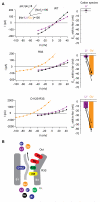The pore of the voltage-gated proton channel
- PMID: 22196334
- PMCID: PMC3244940
- DOI: 10.1016/j.neuron.2011.11.014
The pore of the voltage-gated proton channel
Abstract
In classical tetrameric voltage-gated ion channels four voltage-sensing domains (VSDs), one from each subunit, control one ion permeation pathway formed by four pore domains. The human Hv1 proton channel has a different architecture, containing a VSD, but lacking a pore domain. Since its location is not known, we searched for the Hv permeation pathway. We find that mutation of the S4 segment's third arginine R211 (R3) compromises proton selectivity, enabling conduction of a metal cation and even of the large organic cation guanidinium, reminiscent of Shaker's omega pore. In the open state, R3 appears to interact with an aspartate (D112) that is situated in the middle of S1 and is unique to Hv channels. The double mutation of both residues further compromises cation selectivity. We propose that membrane depolarization reversibly positions R3 next to D112 in the transmembrane VSD to form the ion selectivity filter in the channel's open conformation.
Copyright © 2011 Elsevier Inc. All rights reserved.
Figures








Similar articles
-
A specialized molecular motion opens the Hv1 voltage-gated proton channel.Nat Struct Mol Biol. 2015 Apr;22(4):283-290. doi: 10.1038/nsmb.2978. Epub 2015 Mar 2. Nat Struct Mol Biol. 2015. PMID: 25730777 Free PMC article.
-
Mapping of sites facing aqueous environment of voltage-gated proton channel at resting state: a study with PEGylation protection.Biochim Biophys Acta. 2014 Jan;1838(1 Pt B):382-7. doi: 10.1016/j.bbamem.2013.10.001. Epub 2013 Oct 16. Biochim Biophys Acta. 2014. PMID: 24140009
-
Functionality of the voltage-gated proton channel truncated in S4.Proc Natl Acad Sci U S A. 2010 Feb 2;107(5):2313-8. doi: 10.1073/pnas.0911868107. Epub 2009 Dec 14. Proc Natl Acad Sci U S A. 2010. PMID: 20018719 Free PMC article.
-
Voltage-gated proton (H(v)1) channels, a singular voltage sensing domain.FEBS Lett. 2015 Nov 14;589(22):3471-8. doi: 10.1016/j.febslet.2015.08.003. Epub 2015 Aug 18. FEBS Lett. 2015. PMID: 26296320 Review.
-
Architecture and gating of Hv1 proton channels.J Physiol. 2009 Nov 15;587(Pt 22):5325-9. doi: 10.1113/jphysiol.2009.180265. J Physiol. 2009. PMID: 19915215 Free PMC article. Review.
Cited by
-
A contribution to the history of the proton channel.Wiley Interdiscip Rev Membr Transp Signal. 2012 Sep;1(5):533-557. doi: 10.1002/wmts.59. Epub 2012 Aug 6. Wiley Interdiscip Rev Membr Transp Signal. 2012. PMID: 23365805 Free PMC article.
-
On the control of the proton current in the voltage-gated proton channel Hv1.Proc Natl Acad Sci U S A. 2018 Oct 9;115(41):10321-10326. doi: 10.1073/pnas.1809766115. Epub 2018 Sep 25. Proc Natl Acad Sci U S A. 2018. PMID: 30254162 Free PMC article.
-
Direct Interaction between the Voltage Sensors Produces Cooperative Sustained Deactivation in Voltage-gated H+ Channel Dimers.J Biol Chem. 2016 Mar 11;291(11):5935-5947. doi: 10.1074/jbc.M115.666834. Epub 2016 Jan 11. J Biol Chem. 2016. PMID: 26755722 Free PMC article.
-
On the role of water density fluctuations in the inhibition of a proton channel.Proc Natl Acad Sci U S A. 2016 Dec 27;113(52):E8359-E8368. doi: 10.1073/pnas.1609964114. Epub 2016 Dec 12. Proc Natl Acad Sci U S A. 2016. PMID: 27956641 Free PMC article.
-
CrossTalk opposing view: proton transfer in Hv1 utilizes a water wire, and does not require transient protonation of a conserved aspartate in the S1 transmembrane helix.J Physiol. 2017 Nov 15;595(22):6797-6799. doi: 10.1113/JP274553. Epub 2017 Oct 11. J Physiol. 2017. PMID: 29023730 Free PMC article. No abstract available.
References
-
- Baker OS, Larsson HP, Mannuzzu LM, Isacoff EY. Three transmembrane conformations and sequence-dependent displacement of the s4 domain in shaker k+ channel gating. Neuron. 1998;20(6):1283–1294. - PubMed
-
- DeCoursey TE. Voltage-gated proton channels and other proton transfer pathways. Physiol Rev. 2003;83(2):475–579. - PubMed
-
- DeCoursey TE, Morgan D, Cherny VV. The voltage dependence of nadph oxidase reveals why phagocytes need proton channels. Nature. 2003;422(6931):531–534. - PubMed
Publication types
MeSH terms
Substances
Grants and funding
LinkOut - more resources
Full Text Sources
Other Literature Sources

